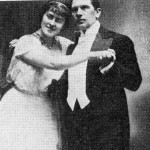Following the Tangomania between 1910 and 1930 in Germany, England and France, other countries joined in as well, and Tango music became popular. One of these countries was Poland, where Tangos have been played in Polish language.
The whole story starts as early as 1913 [1] but the grand time of Polish Tango was in the late 20ies. In 1929 the famous Tango “Tango Milonga” (Lyrics and sheet [2]) was composed by Jerzy Petersburski and directly became an international hit with adaptations in German (“Oh Donna Clara”) and English (“Oh Donna Clara”). Lyrics were written by Andrzej Włast [3], the German lyrics came from Fritz Löhner-Beda and the English lyrics were translated by Irving Caesar and Jimmy Kennedy [4]. Originally the tango was written for Stanisława Nowicka.
Oh, Donna Clara,
I’ve seen you dancing tonight,
Oh, Donna Clara,
I’m in love with you!
Here the original song in an old instrumental version by Henryk Gold and a newer Version of Mieczysław Fogg from 1960.
During the 30ies, the most important tango singers were Tadeusz Faliszewski, Stefan Witas, Mieczysław Fogg, Albert Harris, Janusz Popławski [5].
Here is Mieczysław Fogg with his song “Ostatnia niedziela” (“Last Sunday”, composed by Jerzy Petersburski) from 1936.
Just as a curiosity, here the translation of “Ostatnia niedziela” into Hebrew by polish crooner Adam Aston. The new title is “To ostatni Szabas”. We all know that contemporary Tango had a little affair with Hebrew Klezmer music, so even if this song is of course no Klezmer, maybe this romance has started here.
Here two other songs, one by Mieczysław Fogg: “Serce Matki” (“Mother´s heart”) and “Juz Nigdy” (“Never again”) sung by Sława Przybylska. This is again a composition by Jerzy Petersburski.
Maybe better suited for contemporary listeners is this Tango from Janusz Popławski recorded 1939. The title is ‘Złociste chryzantemy’ which means “Golden Chrysanthemes”. This was one of the last songs before WW2 and it is the masterpiece closing the grand time of Polish Tango [1].
References
1 http://www.todotango.com/english/biblioteca/cronicas/tango_en_polonia.asp
2 http://a-pesni.org/popular-in/polska/milonga.htm
3 http://en.wikipedia.org/wiki/Andrzej_W%C5%82ast

